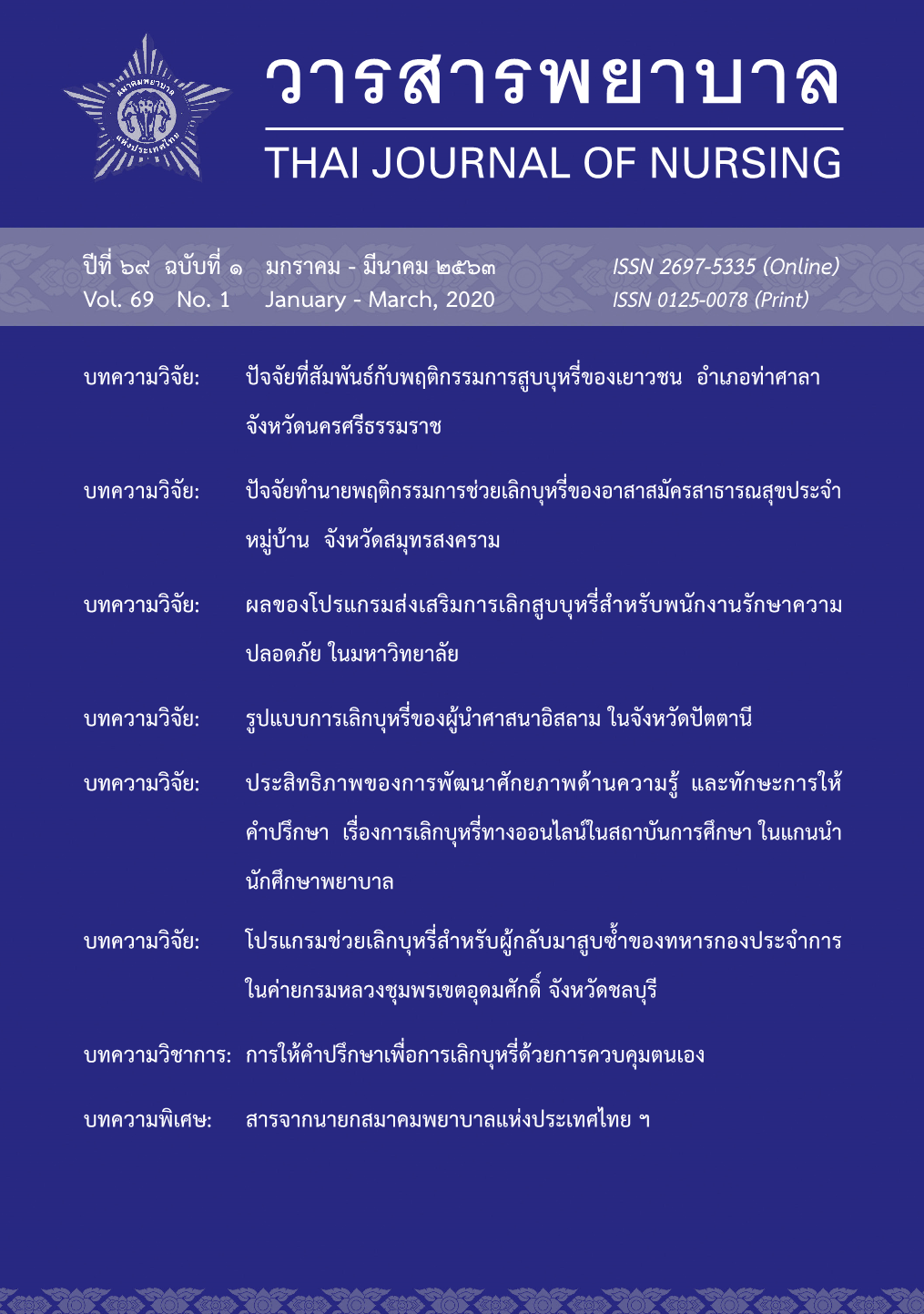A smoking cessation relapse recovery program among the conscript in Prince of Chumphon Camp, Chon Buri province
Main Article Content
Abstract
This quasi-experimental study aimed to study the effectiveness of the smoking cessation program for relapse stage conscript in Prince of Chumphon Camp, Chon Buri province. The sample of 56 conscripts in Prince of Chumphon Camp, Chon Buri province, are in the relapse phase of smoking cessation and in the pre-contemplation stage according to the Transtheoretical model. Each experimental and control group consisted of 28 participants. The experimental group received the smoking cessation program once a week for four consecutive weeks, whilst the control group received no intervention. The data were collected through self-report questionnaires at pre-post intervention and the follow-up period. The descriptive statistics, Chi square test, Fisher’s exact test, One-way repeated measures ANOVA, Paired t-test, and Mann-Whitney U test were adopted for analysis The results showed that after the intervention, the experimental group had higher perceived self-efficacy in smoking cessation than the pre- intervention period with statistical significance (p < .001). However, the between group difference was not found (p >.05). Exhaled carbonmonoxide was decreased in the experimental group when compared to the pre-intervention period with statistical significance (p < .001). However, it revealed no statistical significance when compared to the control group ( p > .05) The nicotine addiction level in the experimental group was decreased when compared to the pre-intervention period and the control group with statistical significance (p < .05). The smoking cessation behavior in the experimental group was greater than the control group and higher at the post-intervention, yet not statistically significant (p > .05). In addition, the smoking cessation success of the experimental group was higher than the control group with statistical significance (p < .05)
Article Details
References
เบญจมาส บุณยะวัน. (2555). ประสิทธิผลของการประยุกต์ทฤษฎีขั้นตอนการเปลี่ยนแปลงพฤติกรรม
ในการเลิกสูบบุหรี่ของเจ้าหน้าที่รักษาความปลอดภัย โรงพยาบาลศิริราช (วิทยานิพนธ์ปริญญา
มหาบัณฑิต ไม่ได้ตีพิมพ์). มหาวิทยาลัยมหิดล, กรุงเทพมหานคร.
ปิยมาศ สวนกูล. (2552). การประยุกต์ใช้ทฤษฎีขั้นตอนการเปลี่ยนแปลงพฤติกรรมในการเลิกสูบบุหรี่
ของทหารเกณฑ์ในค่ายวิภาวดีรังสิต จังหวัดสุราษฎร์ธานี (วิทยานิพนธ์ปริญญามหาบัณฑิต ไม่ได้
ตีพิมพ์). มหาวิทยาลัยมหิดล, กรุงเทพมหานคร.
ผ่องศรี มรกต. (2559). การบำบัดทางเลือกเพื่อช่วยเลิกบุหรี่วิถีไทย(พิมพ์ครั้งที่ 4). กรุงเทพมหานคร:
อัพทรูยู ครีเอทนิว.
ภัทราวุธ โชคประกอบกิจ. (2558). ความสำเร็จในการเลิกสูบบุหรี่: การศึกษาเปรียบเทียบระหว่างผู้ที่
เลิกบุหรี่สำเร็จและไม่สำเร็จ (สารนิพนธ์ปริญญามหาบัณฑิต ไม่ได้ตีพิมพ์). มหาวิทยาลัยมหิดล,
กรุงเทพมหานคร.
มูลนิธิรณรงค์เพื่อการไม่สูบบุหรี่. (2559). การเสียชีวิตของคนไทยต่อปีจากโรคที่เกิดจากการสูบบุหรี่.
สืบค้นเมื่อ 1 พฤษภาคม 2559, จาก https://www.ashthailand.or.th
ศูนย์วิจัยและการจัดการความรู้เพื่อการควบคุมยาสูบ (ศจย.). (2561). รายงานสถิติการบริโภคยาสูบ
ของประเทศไทย พ.ศ. 2561 (พิมพ์ครั้งที่ 1). กรุงเทพมหานคร: เจริญดีมั่นคงการพิมพ์.
สมพงษ์ ลือกลาง. (2556). การพัฒนารูปแบบการช่วยเลิกบุหรี่สำหรับผู้ใหญ่ที่ติดบุหรี่ในหน่วยบริการ
ปฐมภูมิ (สารนิพนธ์ปริญญามหาบัณฑิต ไม่ได้ตีพิมพ์). มหาวิทยาลัยมหิดล, กรุงเทพมหานคร.
สุนิดา ปรีชาวงษ์. (2556). ปัจจัยทำนายการเลิกสูบบุหรี่ในประชากรวัยผู้ใหญ่การทบทวนวรรณกรรม
อย่างเป็นระบบ. วารสารพยาบาลศาสตร์ จุฬาลงกรณ์มหาวิทยาลัย, 25, 16-30.
อาภาพร เผ่าวัฒนา, สุรินธร กลัมพากร, สุนีย์ ละกำปั่น, และขวัญใจ อำนาจสัตย์ซื่อ. (2556). การสร้าง
เสริมสุขภาพและป้องกันโรคในชุมชน: การประยุกต์ แนวคิดและทฤษฎีสู่การปฏิบัติ (พิมพ์ครั้งที่
. กรุงเทพมหานคร: คลังนานาวิทยา.
อารัมภ์พร เอี่ยมวุฒิ. (บก.). (2559). บุหรี่ภัยร้ายทำลายคุณ. กรุงเทพมหานคร: แสงเทียนการพิมพ์.
Bandura, A. (1977). Social learning theory. Englewood Cliffs, NJ: Prentice-Hall.
Chan, S. S., Leung, D. Y., Wong, D. C., Lau, C. P., Wong, V. T., & Lam, T. H. (2012). A randomized controlled trial
of stage-matched intervention for smoking cessation in cardiac out-patients. Addiction, 107(4), 829-837.
coVita. (2011). piCO+ Smokerlyzer: operating manual. Haddonfield, NJ: Author.
Heatherton, T. F., Kozlowski, L. T., Frecker, R. C., & Fagerstrom, K. O. (1991). The
Fagerstrom Test for nicotine dependence: A revision of the Fagerstrom
Tolerance Questionnaire. British Journal of Addiction, 86, 1119-1127.
Polit, D. F., & Beck, C. T. (2003). Nursing research: Principles and methods (7th. ed.).
Philadelphia: Lippincott Williams & Wilkins.
Prochaska, J. O., Redding, C. A., & Evers, K. E. (2015). The Transtheoretical model and
stage of change. In K. Glanz, B. K. Rimer, & K. Viswanath. (Eds.). Health
behavior: Theory, research, and practice (5th .ed., pp. 148-171). San Francisco,
CA: Jossey-Bass.


